..what you are about to witness is a not so common species of spider i came across some days ago, after a morning stroll somewhere around the mountains of North Hellas..
...my big surprise came after digging the internet in order to find some scientific details about this arachnid...
....most probably you will be asking yourself what was the purpose of my 'surprise'... well,first let me tell you that i tried a lot to find some piece of information about the spider that could lead me to some kind of a clue about the species of it..
...my research was really hard as i could not find anything close to my 'beauty'...when i eventually discovered something after at least 10 failed attempts (i thought i had found its species and recognized the spider, faulty, as an Ornamental Tree-trunk spider ), disappointment filled my soul again as my sources were saying that you can find 'this' spider (Ornamental Tree-trunk spider) in Southern Asia especially in countries like India,Malaysia China and New Guinea...
...before saying anything else let me introduce you to Kali - i had to give her a name after all -
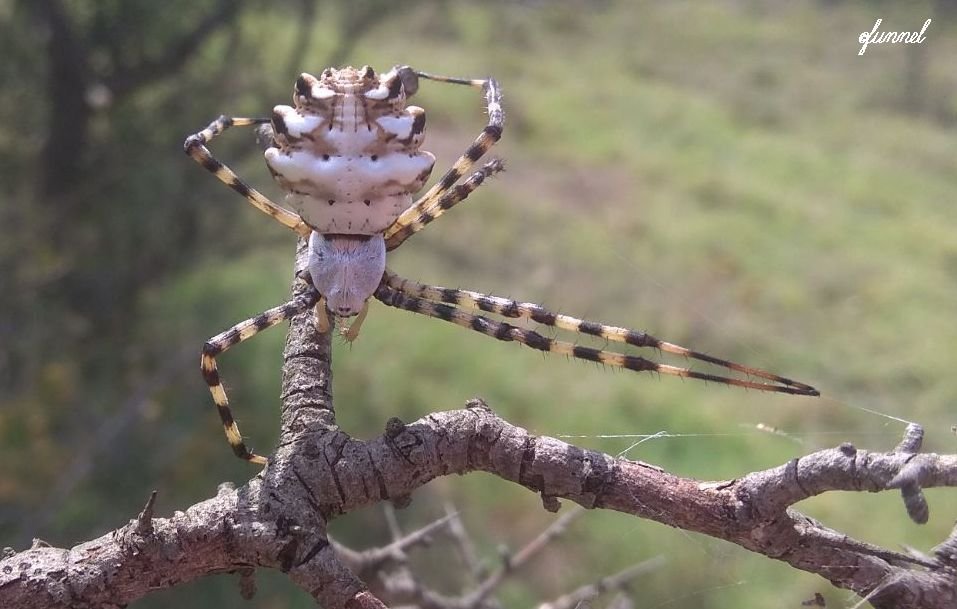 Argiope lobata as i found her (original image)
Argiope lobata as i found her (original image)
-to see images in a large scale right click on them and then click on 'open image in a new tab'
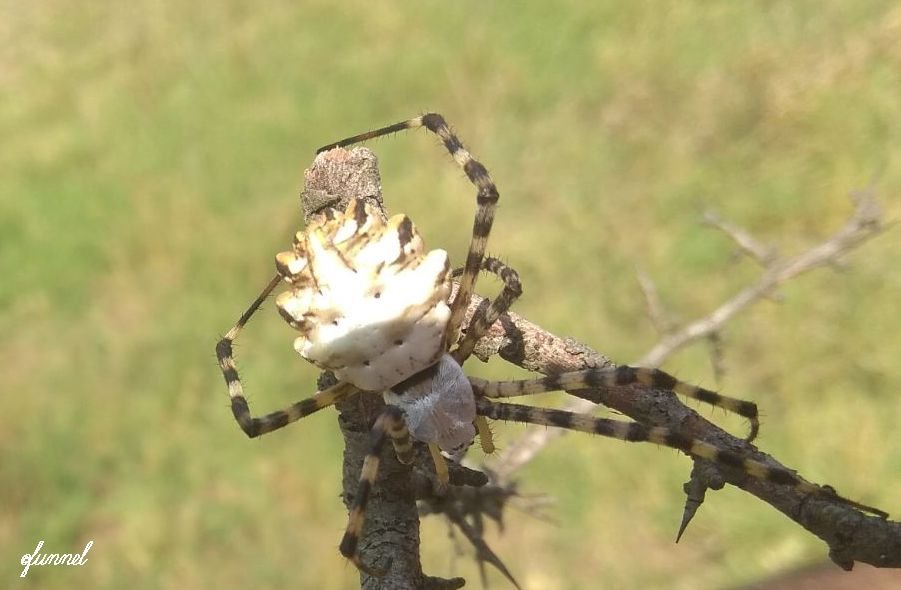 on the move trying to escape (original image)
on the move trying to escape (original image)
...what was really happening if the only places you can find 'Kali' are India,Malaysia and China???... how on earth did i find her on the mountains of Hellas??.. or.... maybe.. is she NOT the one i'm looking for, so i had to continue searching for her origins???
..question marks were racking my brains....just keep in mind that till that point i thought i had in front of me an Ornamental Tree-trunk spider...
.... '' if Southern Asia is your home what are you doing here in Hellas??? ........ maybe you are a political refugee ...maybe you didn't like the food there and you came in Hellas for a better future for your children''...
...what was going on???... i investigated every single inch of 'Kali' and everything,except from the colors of the body, declared to me that i'm dealing with an Ornamental Tree-trunk spider...so what was the case?...
... the answer to that riddle was so obvious but yet difficult to acknowledge..
...when you have no idea where and how to look,if you find something very similar to your search you will get misled no matter what!!!.....
....the answer was 'Kali' IS NOT an Ornamental Tree-trunk spider...
....so obvious....so simple...
....totally by accident and full of surprise i discovered 'Kali' on an image on google ..i was so happy to see her posing as a model on someone's blog..after one last detailed search i found out that 'Kali' is an Argiope Lobata!!!!
..but lets take it from the top....
...we are talking about Argiope lobata (lobed Argiope, λοβωτη Αργιοπη)....
....the name 'Argiope' is 100% Hellenic..it comes from the Hellenic words Αργυρος = silver and ωψ(γενικη - ωπος), προσωπο, οψη = face.....so when you say Argiope you actually mean Silver-faced...
...lobata,lobed is Hellenic as well...it comes from the word λοβος = lobe..
....Argiope falls under Phylum 'artropoda' ( a totally Hellenic word, αρθροποδα ) and Class 'arachnida' (another Hellenic word, αραχνιδια)
...as you can easily understand if we,Hellenes, hadn't lent our language to the scientific community there wouldn't have been a scientific community at all, except from the Hellenic, as they wouldn't have been able to communicate with each other...maybe they have to pay Hellas a copyright fee every time they use a Hellenic word...don't forget....
....in God we trust,the others pay cash!!...
...back to 'Kali'...
...you can easily locate Argiope lobata in Southern and Eastern Europe during the period of summer and autumn..
...furthermore it can be found sporadically in countries like Iraq,Iran,Lebanon,Israel,Dubai even in African countries plus Northern Australia
...'Kali' is actually a true nature ornament...see for yourself!!!!...
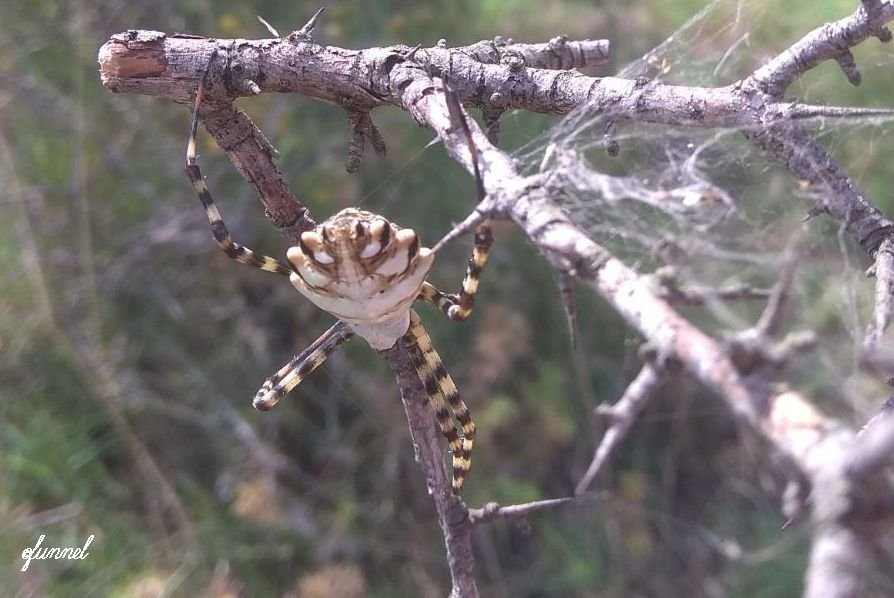 walking on a branch,heads down-clearly seen lobed edges of abdomen (original image)
walking on a branch,heads down-clearly seen lobed edges of abdomen (original image)
....there's something more interesting about this arachnid... it exhibits sexual dimorphism meaning there is a huge difference between the female and the male sex of the spider...the female is huge compare to the poor male....most of the times 4 times bigger in length....that's the reason why i instantly realized that my 'Kali' is a female and i immediately gave her that name..you can see the difference between the two sexes in the image below..
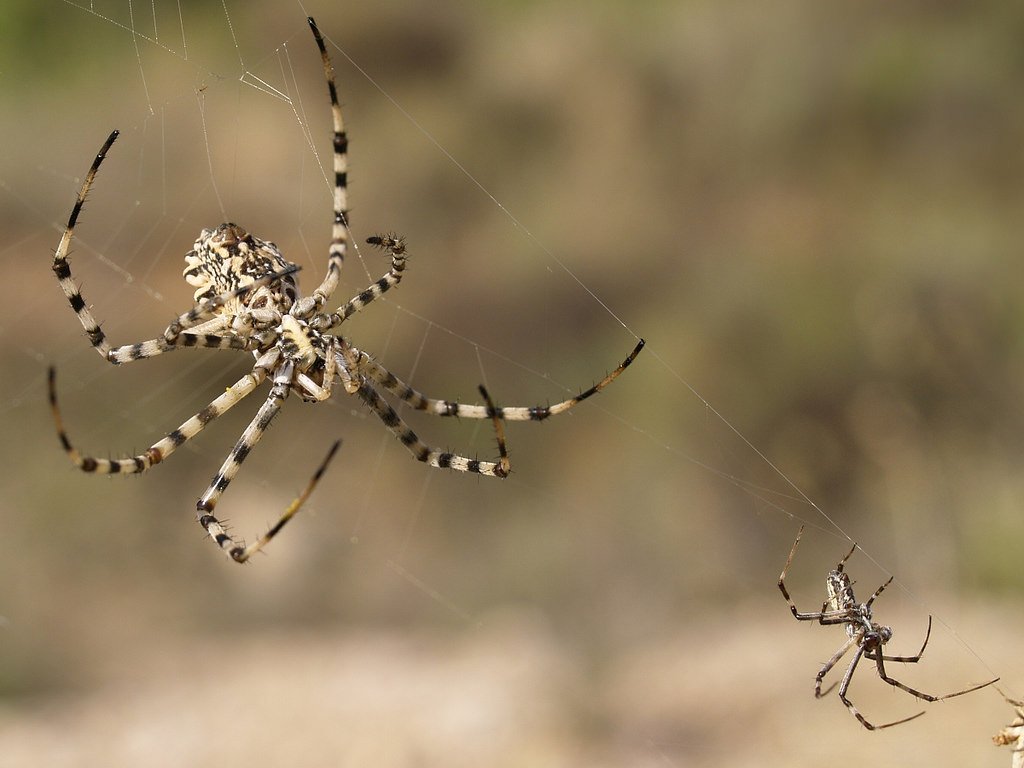
Argiope Lobata, female and male
image source : flickr.com - courtesy of : Ferran Turmo Gort - license : CC BY-NC-SA 2.0
..lets do some anatomy,shall we...
.... the body consists of two parts ...cephalothorax and abdomen..
...cephalothorax, which is the head and the thorax, is remarkably flat clothed with a thick layer of white pubescence....the 'head' forms a trapezium which is longer than wide...wider behind than in front..
..anterior lateral eyes are smaller than posterior lateral eyes....lateral eyes are situated on conspicuous round nodules..
...it has a heart-shaped sternum,pointed behind,which is clothed with pubescence and hair and its color most of the times is brown decorated with a median yellowish-white patch having lateral elongations...
..four pairs of curled legs, long and slender but strong are clothed with hair and spines..its yellowish, with unclear dark annulations, color is one of the most distinctive characteristic of the spider
..one pair of small and weak yellowish Chelicerae (pedipalps) on the spiders' mouth helps her in various functions
..the abdomen is generally flat,round-like shaped,overlapping on the cephalothorax with a yellowish dorsal surface and five pairs of distinct sigilla ( puncture-like black spots where actually muscles are attached internally)..
... the spider's back carries deep furrows which end in lobes-bulges symmetrically placed along the body around the edges...
...the ventral view of the abdomen is blackish-brown with yellow longitudinal stripes running from epigastric furrow to beyond the spinneret,the organ that produces the sticky silk thread..
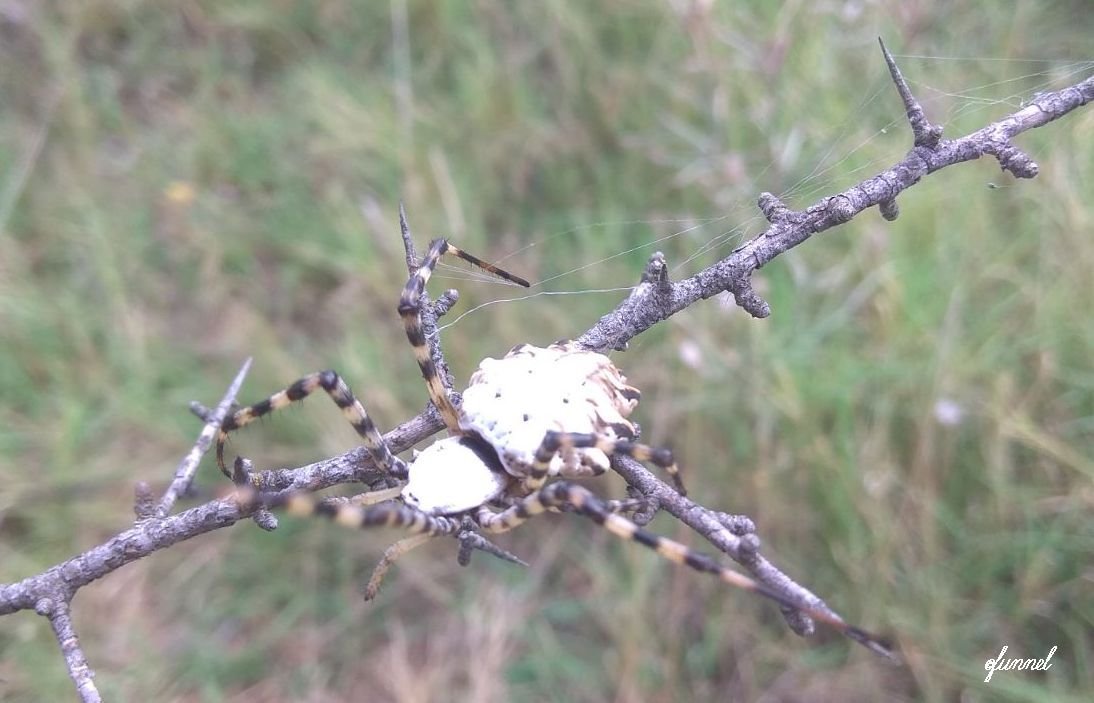
abdomen overlapping cephalothorax (original image)
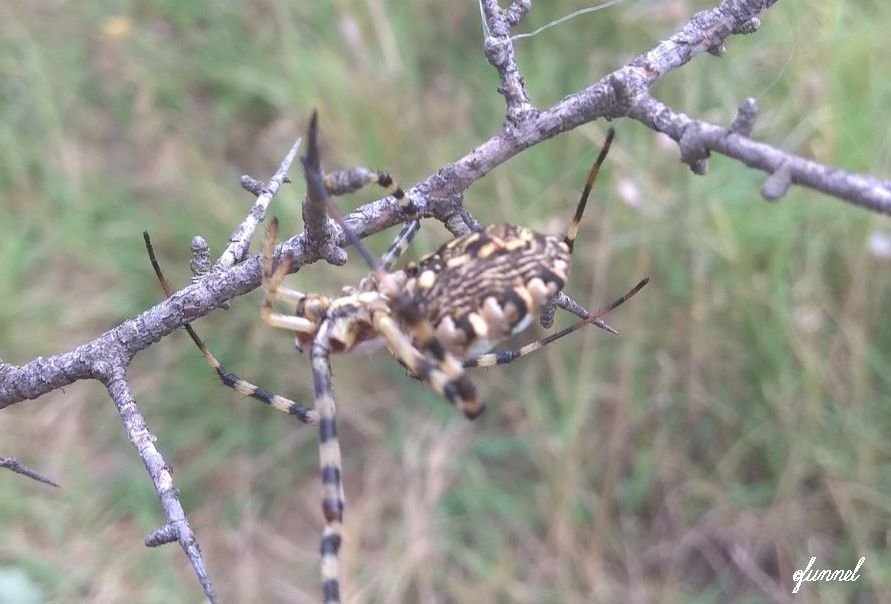
Argiope's ventral view (original image)
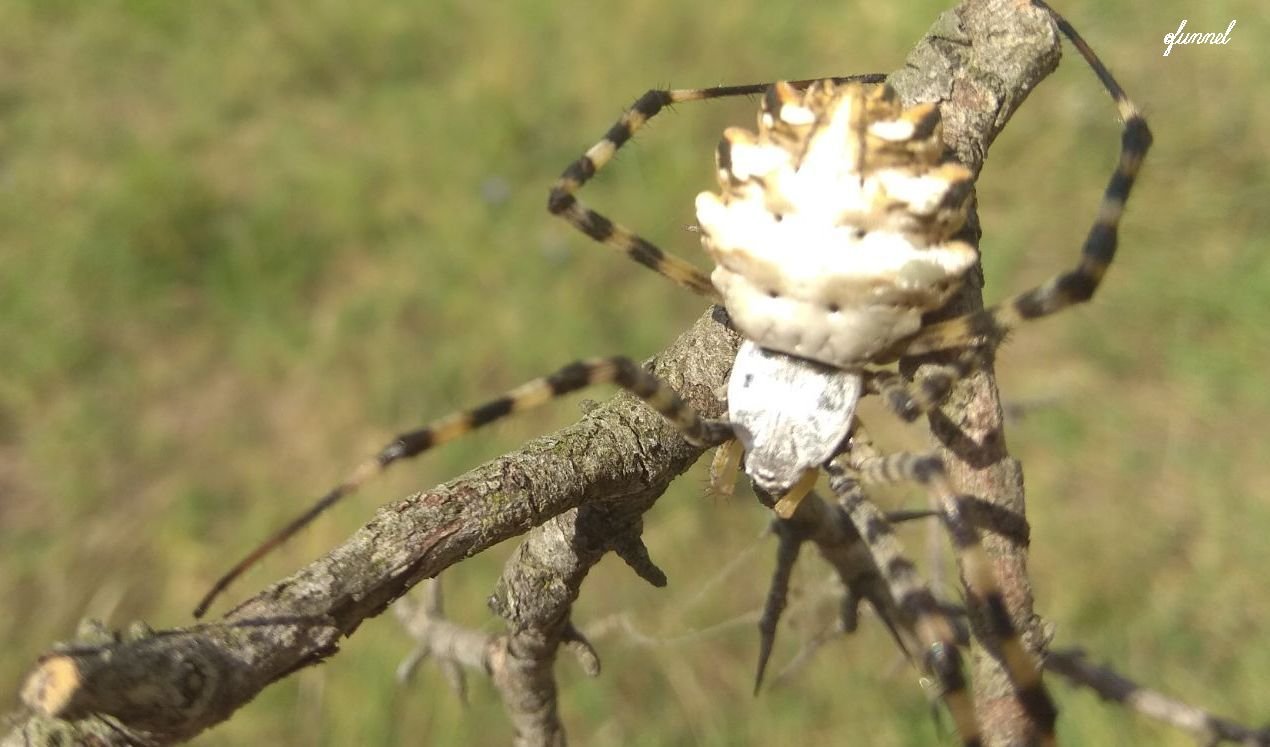
Argiope's dorsal view (original image)
...Argiope habitats dry, very warm and sunny areas in preferable stony bushes and creates its orbicular web into closely spaced radial shaped threads- a coarse inner spiral and a very fine outer spiral...across the inner spiral the spider decorates a prominent white zig-zag stitching forming the so called Stabilimentum...
...the diameter of the orb-web varies from 40-50 mm up to 100 mm usually built one meter above the ground level
...this is exactly the web structure i have found 'Kali' resting but i destroyed it by mistake!!!...shame on me!!!
...the color of the arachnid and the white zig-zag patterns of the Stabilimentum has been speculated to prevent larger creatures (like me) from destroying the web and possibly crushing the spider...
....as you understand it didn't work for me!!!
..Argiope lobata rests in the web head-downwards with its two pairs of forelegs held together and stretched out forwards while the hind two pairs stretching out backwards forming a X-shape....
...whenever a potential prey approaches, Argiope moves to the opposite side of the stabilimentum... after being sure that the prey is trapped the spider runs into it and turns and spins ,sheets of silk around it with her posterior legs..
...after the prey has been paralyzed with venom and its internal organs 'melt' into liquid form the spider sucks it through the silk wrapping...
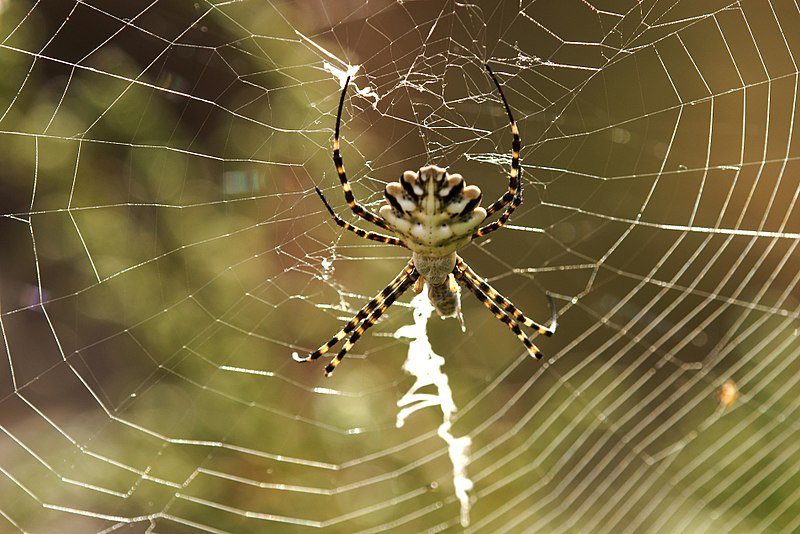 resting head-downwards on her orb-web forming an X-shape with her legs
resting head-downwards on her orb-web forming an X-shape with her legs
image source : wikimedia commons - courtesy of : Ferran Pestana - license : CC-BY-SA-2.0
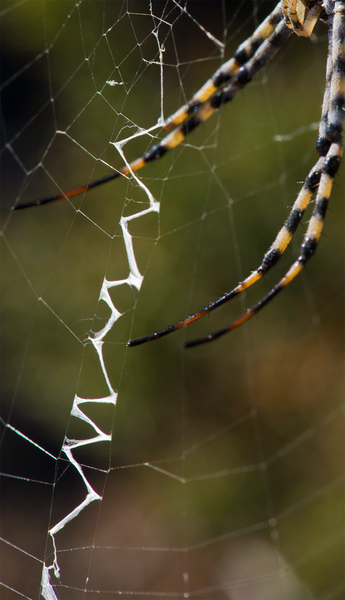
Stabilimentum
image source : wikimedia commons - courtesy of : Javier Virues Ortega - license : CC-BY-SA-4.0
...females can reach 26 mm in length though males a maximum of 6 mm .. i don't know how accurate this is..
..the body length of my 'Kali' was about 30 mm ...yes,she's a big Bitch ...i have a picture to justify my claim..you can get an idea of her length if you compare 'Kali' to my wife's fingers holding the branch..
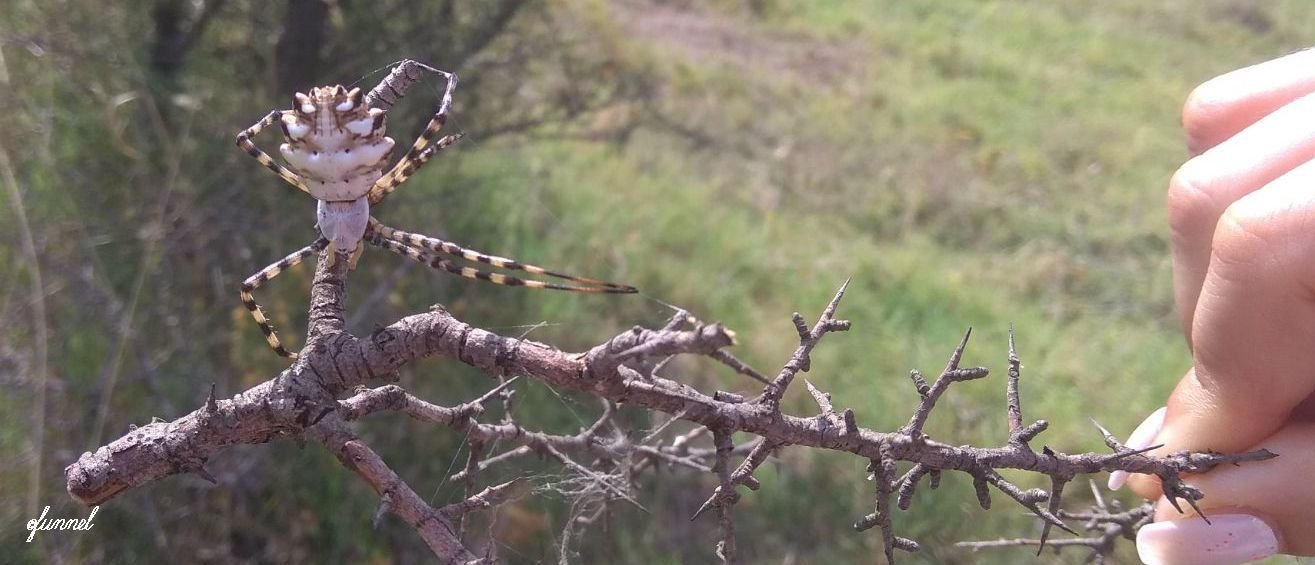 actual size of my 'Kali' around 30 mm in length (original image)
actual size of my 'Kali' around 30 mm in length (original image)
...let me spend a few lines about reproduction for closure...
..mating is a bit 'dark' which is common in many species of spiders,as the female can possibly cannibalize the male after the act!!!
...males can copulate at a maximum of two times in their life and eventually die after mating!!!......
...a male's reproductive success depends very much on the quality of the female...by quality we mean the body size and mass so males tend to choose large and heavy females!!!
...the problem is that high-quality females attract more than one males which leads them to competition...
..a male can monopolize a female though, through the application of mating plugs..this happens as the male blocks the female's genital openings with its pedipalps..
...pedipalps are being used in order to transfer sperm in the female and right after copulation males cut off one or both of their organs making themselves totally or partly eunuchs..plugging moreover increases the risk of sexual cannibalism..so they have to choose...eunuch or departed?!
...scientists presented males with virgin females of different fecundity..this happened either in the presence or absence of a rival male..the outcome was that males preferred larger females when they were under competition with another 'applicant' while they were not willing to invest in paternity when the female was small!!!
...in conclusion size does matter in Argiope's lobata mating and a male doesn't care even to risk his own life in order to fertilize a BIG lady!!!
...Argiope lays its eggs into heart-shaped sacs which are very well camouflaged..they contain approximately 1000 eggs! but only 2% of them survive to become adult spiders...surprisingly a female can build up to 3 cocoons every two weeks..
....can you imagine our world if 50% of these youngsters could survive???....ARACHNOPHOBIA reaches our doorsteps!!!!
....luckily Argiope lobata is harmless to humans so its a friendly arachnid!!!
...i really am so excited and so happy i came across Kali, it was the first time in my life and probably my last i discovered an Argiope lobata...
....in a word...she was MAGNIFICENT!!!!
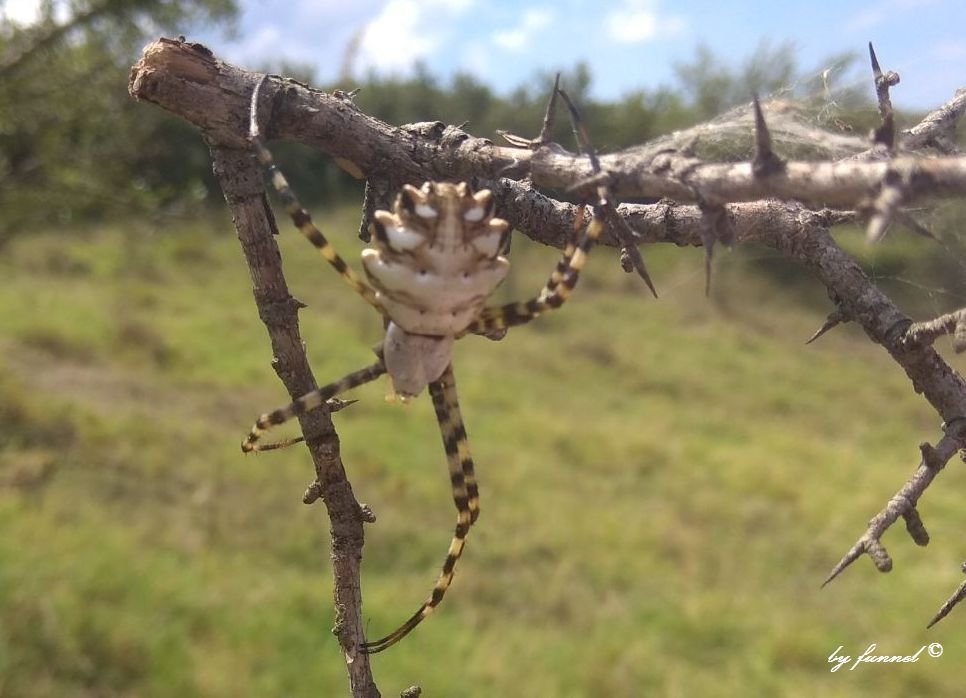 Argiope Lobata - my 'Kali' (original image)
Argiope Lobata - my 'Kali' (original image)
..if you would like to see how Argiope treats her guests you can see the following youtube video from Joacin Cid Leal ...enjoy!!!

P.S. something you may not have noticed in my images...Kali is missing two of her right legs...probably she lost them in some kind of a fight
